List of Authors
>>About this blog
Recent blog post
|
[Sam]
May 16, 2014 09:00
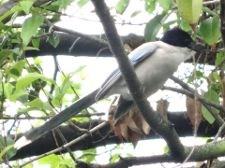 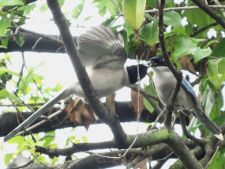
At this time, every time you pass through Tsukuda Park, you often see a few nagas flocked, singing with a slightly hoarse voice, such as "Ge", "Ge", and "Ge", and flying around.
(It is said that in the spring, it is also observed that they screamed with an adorable voice such as "Kuriri ...")
This time, I found pom, which I thought was the turn.
Apparently, May-July seems to be the breeding season.
As the name comes from, Onaga has a long tail feather, a smart body shape, and a neat feather color, but surprisingly a resident bird belonging to the crow family.
It is also interesting that the distribution area of Onaga is considered to be two distant regions (enclave distribution) at both east and west ends of the Eurasian Continent.
In Japan, it is currently inhabited locally north of central Honshu and is very common in the Kanto region, but it is said that there are many places where this species is not distributed in neighboring areas.
They live in mountains, villages, green areas, parks, etc., act in flocks, and feed is considered omnivorous.
The body length is 34-39cm, the tail feather is 20-30cm, and the head and body are large starlings.
Black as if you were wearing a hood completely from the tip to the back of the head.
It is grayish white from the neck, throat to the chest.
The wings and tail feathers are blue-gray, the back is pale grayish brown, and the same sex color.
When flying, the long tail stands out well, and it looks more gliding than flying.
In addition, like other birds of the Crow family, they have high learning ability and are very cautious.
In addition, it has been reported that they are often nested in cuckoos.
[Kanbe]
May 15, 2014 17:00
Last Sunday, I went to Ginza UNIQLO.
The opposite Matsuzakaya was gone.
Site of Matsuzakaya
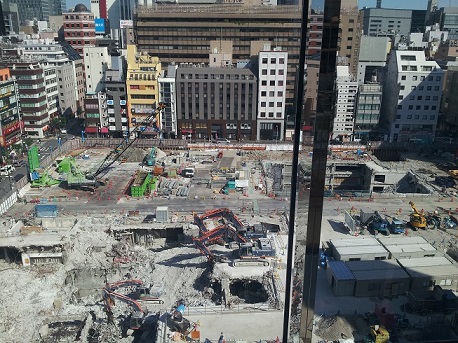
What kind of building is it?
I also hear that the Kanze Noh Theater is moving from Shibuya.
I'm looking forward to it.
[Conquering Show Lew ☆]
May 15, 2014 14:00
When I studied about "bridges", I was interested in structural design, etc., and when I looked up to visit nearby bridges, there are many wonderful bridges in Chuo-ku!
Nihonbashi Eitai Bridge Kiyosubashi Kachidokibashi 8 bridges Sumida River, a nationally designated important cultural property...
(In the future, I would like to introduce the bridge in Chuo-ku on this blog!)
Finally, I wanted to see the bridge below and decided to sail from the Nihonbashi Pier.
There are various ships and courses, but I chose the Nihonbashi River course of the "Edo Tokyo Discovery Consortium" of course.
I am very satisfied with a fun commentary and old map with a valuable and high-sense American electric boat!
If you're lucky, you're in a chartered state!
We recommend departing from Nihonbashi during this time when the climate is good!
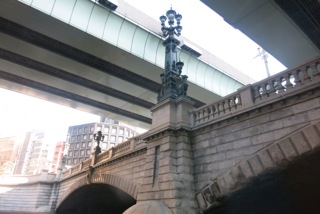
[Mido]
May 15, 2014 09:00
For Japanese people, chopsticks are eaten as soon as they are born.
I use chopsticks for the first time, and when I die, I cremate and pick up my bones with chopsticks.
I think it's a tool that can be used for a lifetime.
This time, "Ginza Natsuno" is a shop specializing in chopsticks, about 2,000 types.
Chopsticks are lined up, and it looks like a museum of chopsticks.
"Takaga chopsticks, but chopsticks" ~ Feel the depth of chopsticks with your skin.
You can do it.

The interior of the store has a "Japanese atmosphere" and has a very calm mood.
For pasta, grilled fish, chopsticks for mixing natto, etc.
There was also something unique.
The price is reasonable at 300 yen, and it costs 150,000 yen.
That's all right.
Materials such as wooden, glass and pottery chopsticks and high-grade ivory.
There are a lot of things.
Chopsticks made using traditional techniques such as Wajima-Nuri, Tsugaru-Nuri, and Wakasa-Nuri.
I think it may be a gift.

The shop gave me such advice.
In order to use your favorite chopsticks for a long time, daily care is important.
It seems that draining water is the trick to last long. Wooden chopsticks
When the oil of the wood becomes whitish, a small amount of olive oil
I think it's a good idea.
----------------------------------------------------
Ginza Natsuno, a shop specializing in chopsticks, http://www.e-ohashi.com/
6-7-4, Ginza, Chuo-ku, Tokyo
TEL: 03-3569-0952
Mon-Sat 10:00-20:00 Day/holiday 10:00-19:00
[Kenken]
May 14, 2014 14:00
A pleasant season with refreshing sunny weather from morning and not high humidity. At that time, I went out to walk along the Sumida River.
There are bridges with various characteristics on the Sumida River flowing through the middle of Chuo-ku and its surroundings, and it is quite good to walk upstream along the Sumida River Terrace while watching them one by one.
The starting point is near the mouth of the Sumida River, a bridge under construction that connects the Kachidoki area and the Tsukiji area as Loop Route 2. The day was only on both banks, but at a later date the "peace" in the middle was put on, and the bridge finally took place!
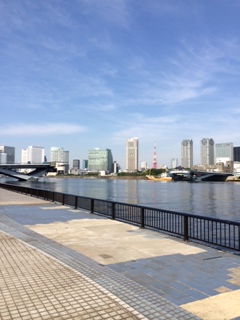 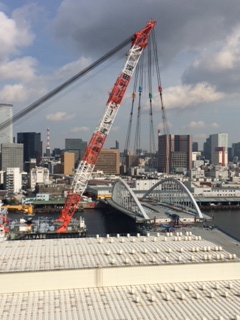
Next is Kachidokibashi. It's a movable bridge (Futaba Jumping Bridge) that was built in 1940. It is said that it has not been opened or closed....。
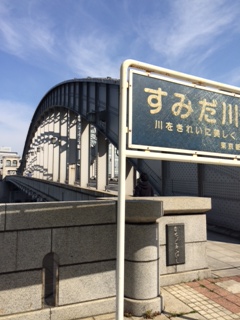
As you follow Nishinaka-dori, "Nishinakabashi" was recently rebuilt beautifully. You can also meet the sight of a houseboat waiting for the turn moored.
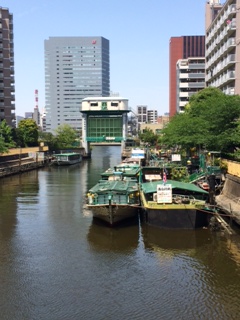
Tsukuda-ohashi Bridge is located near Sumiyoshi-jinja Shirine (Tsukuda 1-14), a local guardian god. This bridge was built in place of the ferry "Tsukuda's ferry" that started in 1645.
Also, it would be nice to see "Tsukuda Kobashi" from near the base of this bridge. The high-rise apartments towering in the back of the scenery since ancient times are also superb.

When you take a walk around this area, you will always come to Tenan (Tsukuda 1-3-14), a long-established store of Tsukudani-ya, but since you hurry ahead, you will pass in front of the shop on this day I did it. Actually, the reservation time for "Shanghai Dining" (Tsukuda 2-1-13) along Chuo-ohashi Bridge was barely reached. The Chuo-ohashi Bridge seen from the terrace seats of this shop can be very powerful.
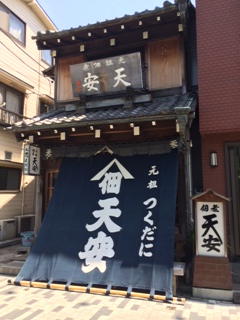 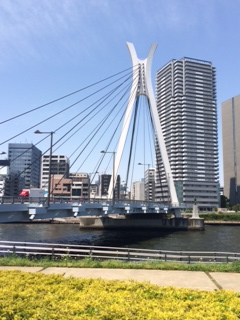
After the meal, cross the Chuo-ohashi Bridge and start walking on the left terrace in the direction of travel.
"Eitai Bridge" is a bridge built to celebrate the 50th anniversary of the 5th Shogun Tsunayoshi Tokugawa. However, the current bridge is from 1926. There seem to be various theories about the origin of this bridge, such as "I hope the Tokugawa Shogunate will continue for generations for many years."
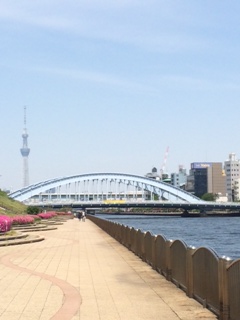
Toyomi Bridge is a bridge that spans the Nihonbashi River, which is separated from the Sumida River. It's a unique shape like a ladder lying down. I also have a dog from my home with walking.
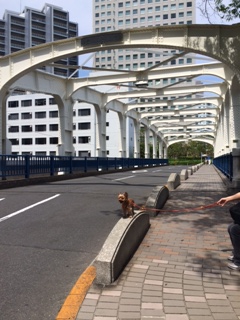
"Sumida River Ohashi" is a two-story building with the Metropolitan Expressway and a general road. In terms of design, it emphasizes function only (?) It's a bridge. On the other hand, the next "Kiyosu Bridge" has a beautiful form. I'll try to change the taste of the picture.
 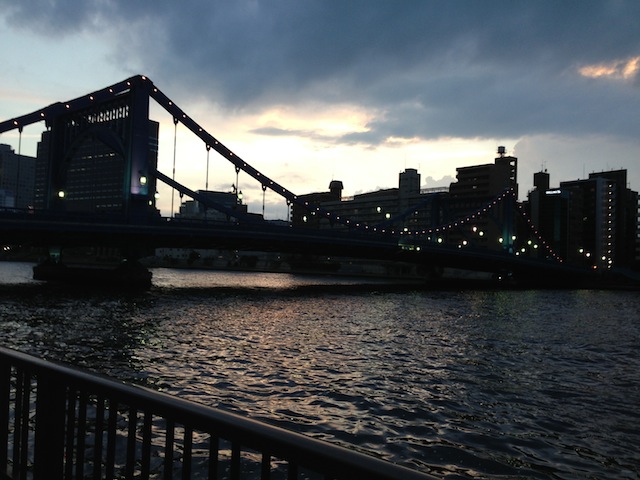
"Shin-ohashi Bridge" is a bridge that survived the fall and saved many lives during the Great Kanto Earthquake. I wonder if the color of the stole is unique.
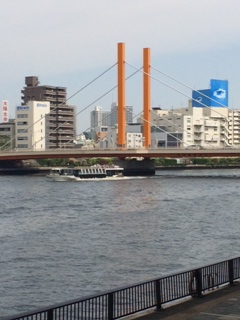
And the goal of this day is "Ryogoku Bridge".  The performance of the brass band club, which was heard from nearby Nihonbashi Junior High School, was also felt as a reward for walking. The performance of the brass band club, which was heard from nearby Nihonbashi Junior High School, was also felt as a reward for walking.
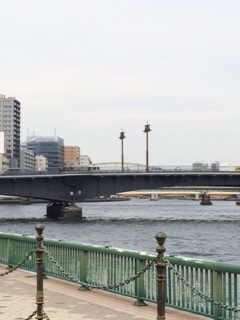
Thank you very much.
1.
May 14, 2014 09:00
"Kappo cuisine Shimamura" is a long-established store founded in 1850 (1850) just after entering the corner of Mizuho Bank at the central exit of Yaesu. Since Perry arrived in 1853 (1853), he set up a store as "Shimamura of the caterpillar" on the eve of the turbulent late Tokugawa shogunate. It's also in the shop. In 1861 (1863), "Oedo Cuisine Numbering" is a famous restaurant that has been treated separately as a Gyoji along with "Hira Kiyo" and "Yaozen". This shop was loved by politicians and cultural figures such as Ito Hirobumi and Kaoru Inoue during the Meiji period.
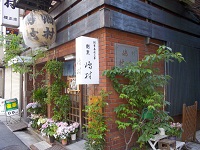
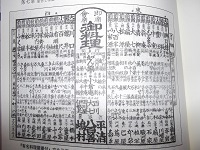
There are many exposures to TV and magazines, so many of you may know, but this time we will introduce "late Tokugawa shogunate Kaiseki", a special menu limited to Saturday.
The menu is as follows. "Wild sesame vinegar", "Uzura bowl", "sashimi", "sea bream helmet boiled", "Horaku steamed egg" (mix boiled chicken and shiitake mushrooms with the beaten egg, roast them and steamed in the sun)
"Kinpura" (Tempura, 3 shrimp made with egg yolk melted and raised with sesame oil) "White rice, incense food, miso soup" "Water confectionery"
The drink says, "Isn't there a lot of local sake not only going down at this time?" Although he said, "I didn't have beer yet, it's a bad way," it was just a "draft beer" because it was sweaty.
late Tokugawa shogunate seats are 3800 yen (excluding tax) Saturday night and night only for 30 meals. How about relaxing in the tatami room and enjoying Edo talks?
1-8-6 Yaesu, Chuo-ku, Kappo cuisine Shimamura 1-8-6 TEL3271-9963 Business hours 11:30-14:00, 16:30-22:30
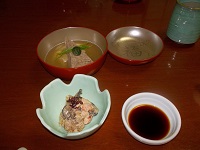 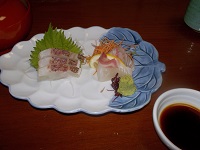 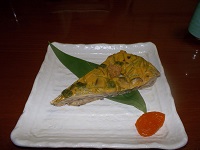 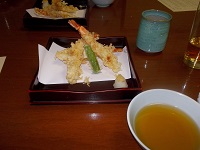
|
Links
|







